Introduction
In today’s fast-paced business landscape, the importance of a seamless employee onboarding experience cannot be overstated. Organizations are increasingly recognizing that automating this process is not merely a convenience, but a strategic imperative that can enhance operational efficiency and foster employee satisfaction. By integrating technology into onboarding, companies can significantly reduce the time spent on administrative tasks, allowing new hires to feel welcomed and engaged from day one.
This article delves into the transformative benefits of onboarding automation, outlining practical steps to implement it effectively, and addressing common challenges that organizations face. Additionally, by measuring the success of these initiatives, businesses can ensure they are creating an environment that not only attracts talent but also retains it, ultimately driving long-term success.
Benefits of Employee Onboarding Automation
Automating the staff orientation procedure transforms how companies incorporate new recruits, greatly decreasing the time and effort usually required. By leveraging technology to manage administrative tasks, companies can create a more engaging and welcoming experience for new staff right from their first day. This approach not only fosters a sense of belonging but also enhances overall job satisfaction, which is critical for retention.
For instance, companies in the financial sector often face stringent regulations requiring effective training for new staff. By automating their orientation processes, organizations can ensure compliance with these regulations while also providing an engaging introduction to their corporate culture. As noted by Karmela Peček, an instructional designer at eWyse Agency, transforming complex technical data into user-friendly formats encourages new team members to explore and understand their roles more effectively.
The advantages of improved orientation experiences are evident in retention statistics; workers are more inclined to remain with organizations that emphasize effective introduction processes. As stated in the 2024 Experience Trends Report from Qualtrics, as worker expectations continue to increase, those who feel appreciated during the initial orientation are more likely to contribute positively to the workplace. As Nir Leibovich, co-founder and CEO of GoCo, emphasizes, concentrating on staff rather than time-consuming HR tasks enables companies to foster a supportive environment that promotes long-term loyalty.
In summary, automating the orientation procedure not only simplifies administrative tasks but also fosters a welcoming environment that aligns with the changing demands of today’s workforce.
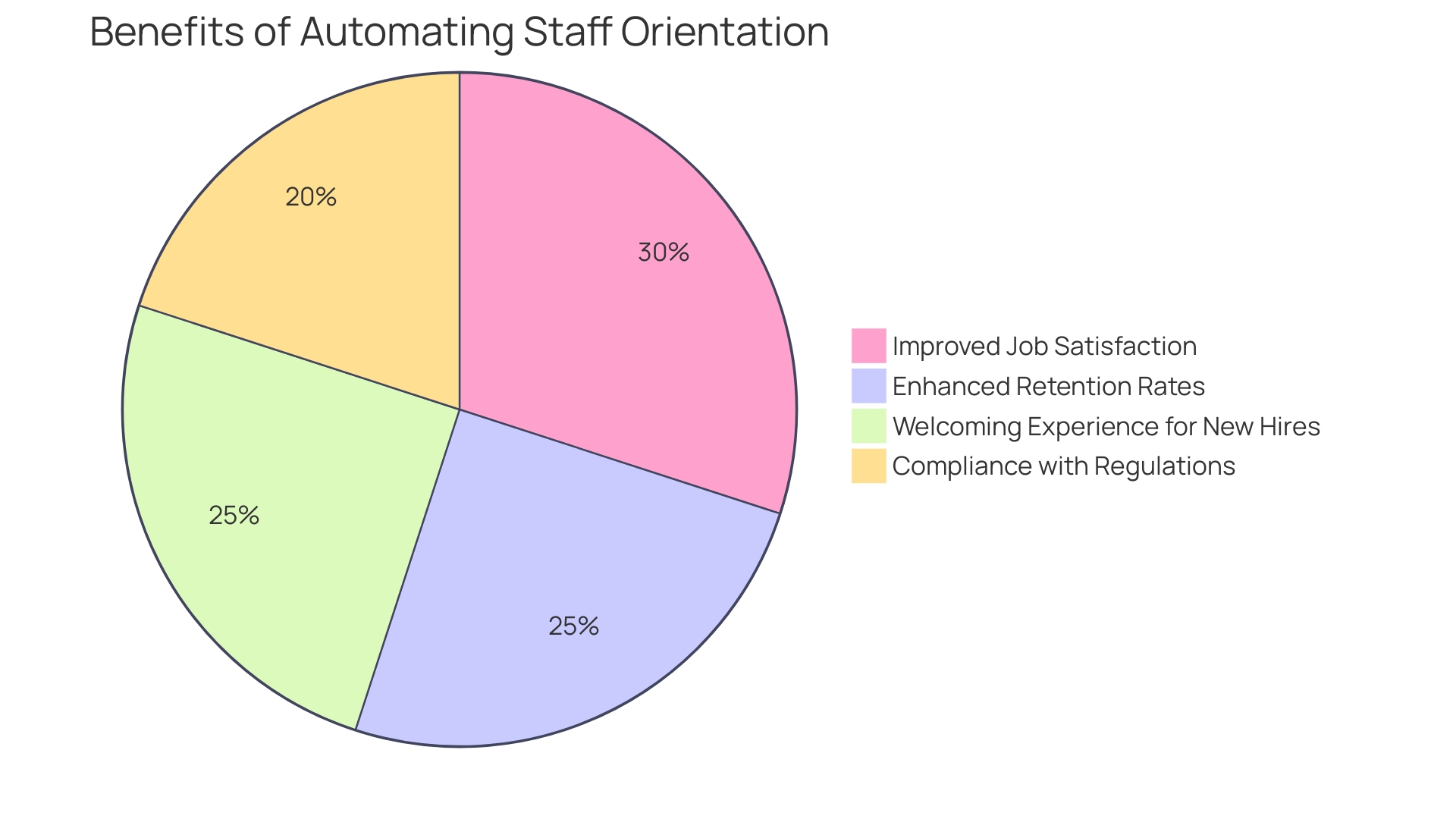
What Tasks Can Be Automated in Employee Onboarding
The mechanization of different activities during the employee integration system demonstrates a significant transformation for companies aiming for operational excellence. Key tasks such as document collection, training schedule creation, benefits enrollment, and compliance training can be seamlessly automated. This change not only speeds up the integration timeline but also greatly decreases the likelihood of human mistakes that frequently come with manual tasks. For example, a fast-growing startup recently leveraged automation to streamline its onboarding, enhancing alignment on necessary tasks and improving overall efficiency.
By automating these steps, organizations can ensure that no critical detail is overlooked. This is particularly crucial for compliance training, where missed steps can lead to significant consequences. In reality, automating tasks has demonstrated the ability to save an average of 35 minutes per request, as illustrated by Delivery Hero, which encountered difficulties with staff being locked out of their accounts. By refining their processes, they managed to reclaim valuable time for employees, allowing them to focus on their core responsibilities rather than getting bogged down in administrative hurdles.
The integration of intelligent document processing is a vital consideration when executing mechanization. Organizations should first evaluate their data processing requirements—identifying whether their data is structured or unstructured—and the amount of information that needs mechanization. Targeting documents that traditionally consume a lot of manual processing time, such as invoices and contracts, can yield substantial efficiency gains. This targeted approach can lead to notable cost savings and enhanced productivity, allowing HR professionals to redirect their efforts toward more strategic, people-centered initiatives. By embracing automation, businesses can not only enhance their employee integration processes but also cultivate a more dynamic and efficient workforce.
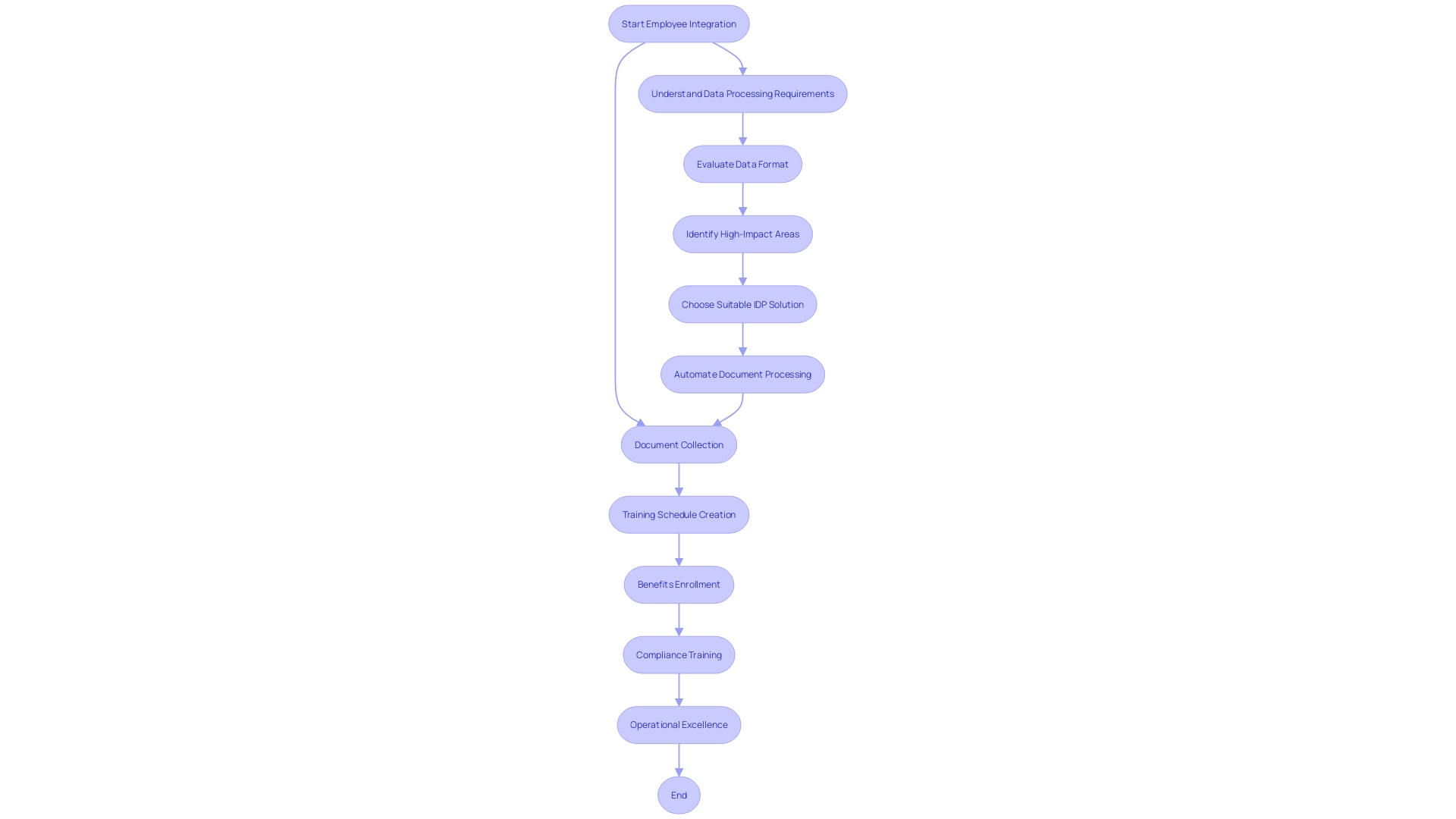
Step-by-Step Guide to Automating Employee Onboarding
Automating employee integration requires a strategic and well-organized approach to maximize efficiency and minimize the burden on HR teams. Begin by pinpointing the specific onboarding tasks that are repetitive and time-intensive. Shared spaces suitable for mechanization encompass familiarizing new employees with the organization’s culture, important policies, and compliance standards, especially in regulated sectors where grasping legal structures is vital.
Once the tasks are identified, select tools for mechanization that align with your organization’s unique needs. Look for platforms that offer personalized eLearning experiences, enabling new employees to engage with onboarding materials tailored to their specific roles and progress. For example, data-driven eLearning systems can adapt content based on individual performance, ensuring that new hires gain the necessary skills and knowledge effectively.
After selecting the right tools, proceed with implementing the automation solution. This phase is crucial: ensure that all stakeholders, from HR personnel to department managers, are adequately trained and informed about the new procedures. By promoting a culture of collaboration and transparency concerning the changes, organizations can reduce resistance and improve the integration experience. As companies maneuver through this shift, it’s vital to acknowledge that the incorporation of AI and mechanization technologies will not only enhance workflows but also generate chances for innovation and increased worker involvement.
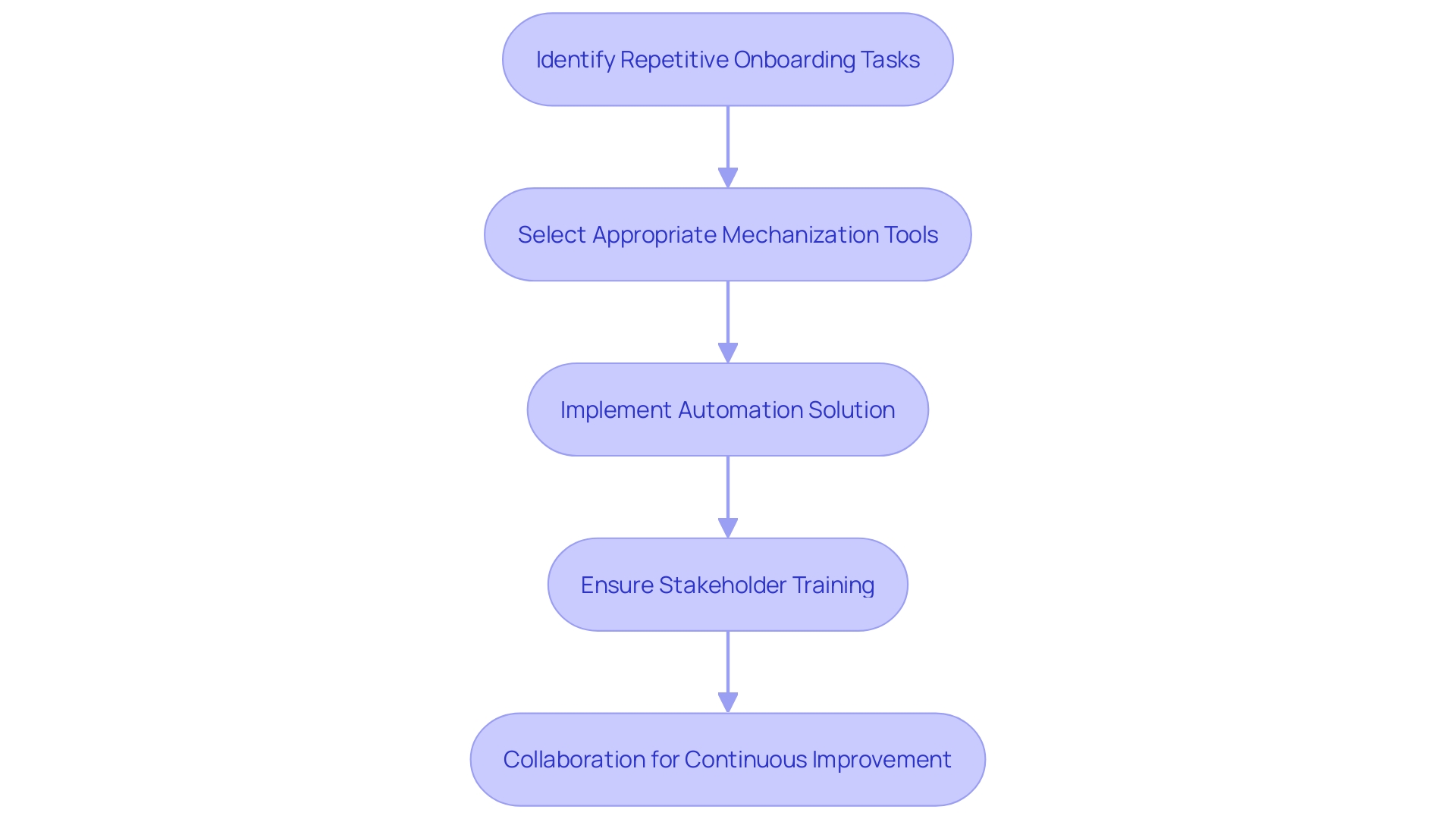
Common Challenges and Solutions in Onboarding Automation
Automating the onboarding procedure presents a wealth of advantages, yet organizations often encounter significant hurdles. Typical obstacles involve staff resistance, challenges in merging new technological tools with current systems, and the intricacies of maintaining adherence to legal standards.
To navigate these challenges effectively, it’s crucial to adopt a comprehensive approach that prioritizes change management. A organized collection of methods, tools, and techniques can reduce opposition and enhance the advantages of automation. Comprehending the effect of changes on staff and addressing potential concerns is essential. Successful change management is not solely about technical implementation; it’s about winning the hearts and minds of your team. For instance, Nets, a provider of digital payment solutions, faced similar obstacles when revamping their onboarding process. They focused on presenting technical data in user-friendly formats, which not only engaged employees but also encouraged them to explore the information independently.
Choosing flexible automation tools can facilitate smoother integration with existing systems. A recent survey revealed that 87% of organizations plan to increase their investments in AI, highlighting the growing recognition of its potential in enhancing operational efficiency. Moreover, staying up-to-date with compliance regulations is critical. Regularly reviewing these regulations ensures that automated processes align with current legal standards, thus mitigating risks associated with non-compliance. By taking these proactive steps, organizations can transform their orientation experience and set the stage for a more engaged and productive workforce.
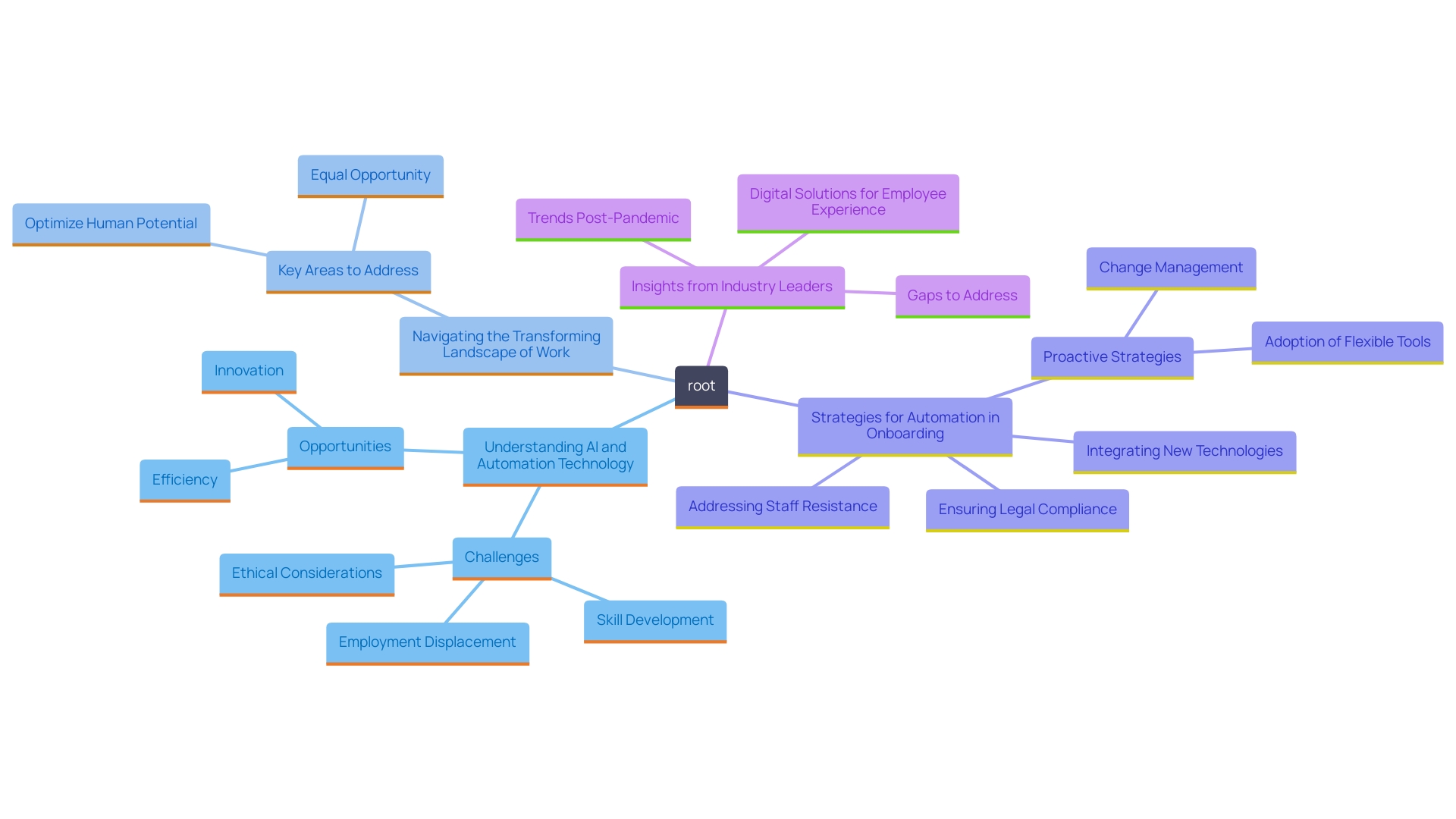
Measuring the Success of Onboarding Automation
Monitoring the efficiency of automation during the initial employee integration necessitates attention to multiple crucial performance metrics (KPIs) that represent the overall acclimatization experience. Organizations should closely monitor metrics such as time-to-productivity, employee satisfaction scores, and retention rates. For instance, research indicates that over 45% of workers leave their jobs within the first year, often due to inadequate training experiences. By consistently examining these metrics, organizations can recognize gaps and opportunities within their onboarding systems.
A case in point is Delivery Hero, which faced significant challenges with staff account access, leading to an average of 800 lockout requests per month. By streamlining their processes and implementing automation, they reduced the time to regain access, allowing staff to return to work promptly, thus enhancing overall productivity. ‘Likewise, Kabannas, the hotel group, intends to enable its visitors by enhancing their digital interactions, which can be reflected in a staff training context.’. This emphasizes the importance of ensuring that new hires feel engaged from the start.
Moreover, the 2024 Workforce Experience Trends Report emphasizes that staff members increasingly anticipate a smooth integration process that meets their personal needs and preferences. Organizations should leverage data from their existing systems to refine the onboarding process continually. This strategic application of automation not only enhances employee engagement but can lead to improved retention and customer satisfaction, ultimately translating into better business results.
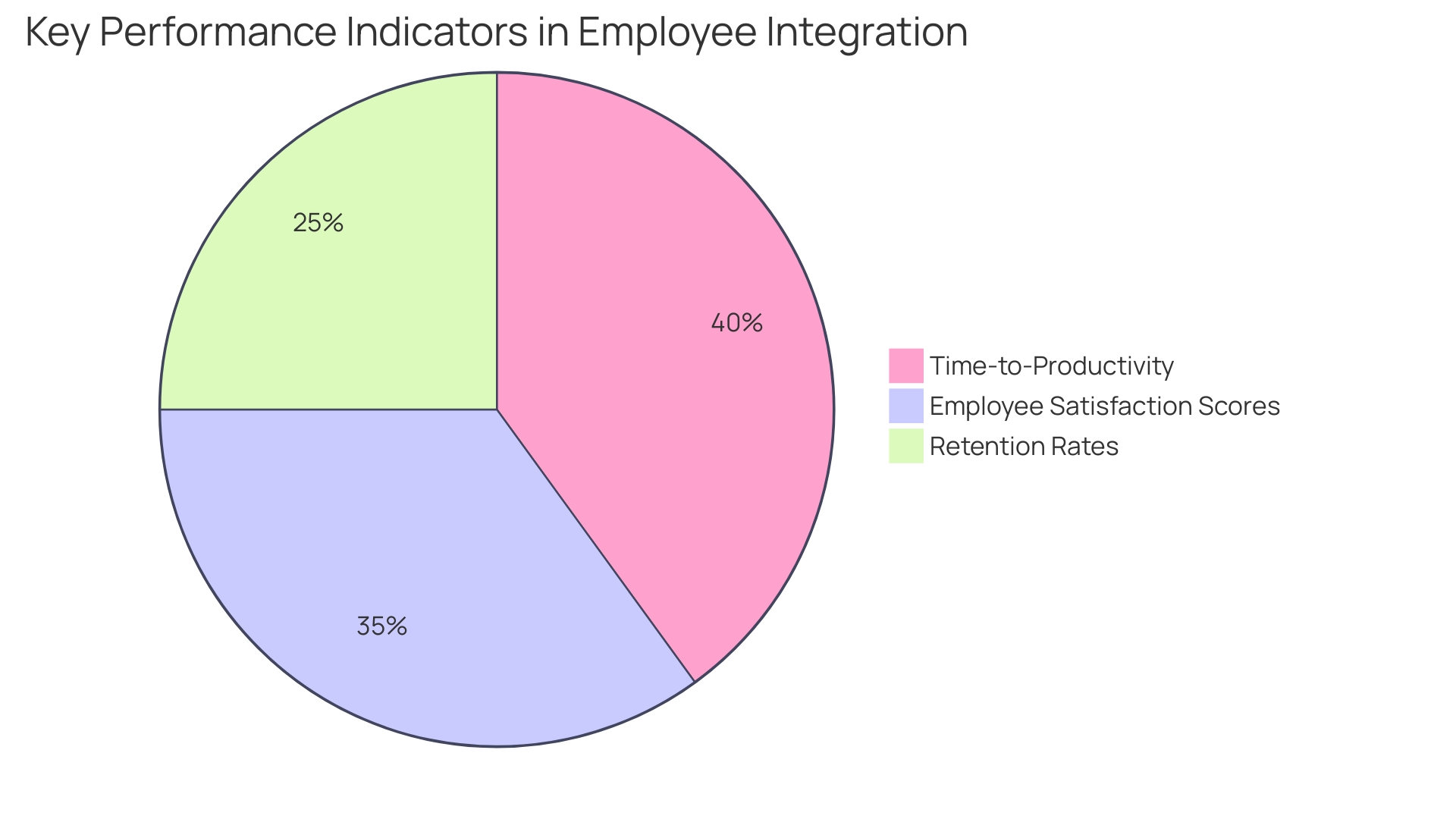
Conclusion
Automating the employee onboarding process offers transformative benefits that extend beyond mere efficiency. By streamlining administrative tasks, organizations can create a welcoming and engaging experience for new hires, which is crucial for enhancing job satisfaction and retention. As highlighted, companies that prioritize efficient onboarding not only comply with regulatory requirements but also foster a culture that values employee contributions from day one.
The automation of critical tasks such as document collection and compliance training significantly reduces human error and accelerates the onboarding timeline. Implementing intelligent document processing can lead to substantial efficiency gains, allowing HR professionals to focus on strategic initiatives rather than getting bogged down in repetitive tasks. By identifying areas ripe for automation and selecting the right tools, organizations can ensure that no detail is overlooked and that new employees are well-prepared for their roles.
While challenges such as employee resistance and system integration may arise, adopting a comprehensive change management strategy can mitigate these issues. Highlighting the importance of user-friendly communication and training can help win employee support and facilitate smoother transitions. Regularly measuring the success of onboarding automation through key performance indicators enables organizations to identify gaps and continuously refine their processes, ensuring they meet the evolving expectations of the workforce.
In summary, the integration of automation in employee onboarding is not just a tactical improvement but a strategic necessity. By embracing this shift, organizations can cultivate a more dynamic, engaged, and productive workforce, ultimately driving long-term success and retention.

